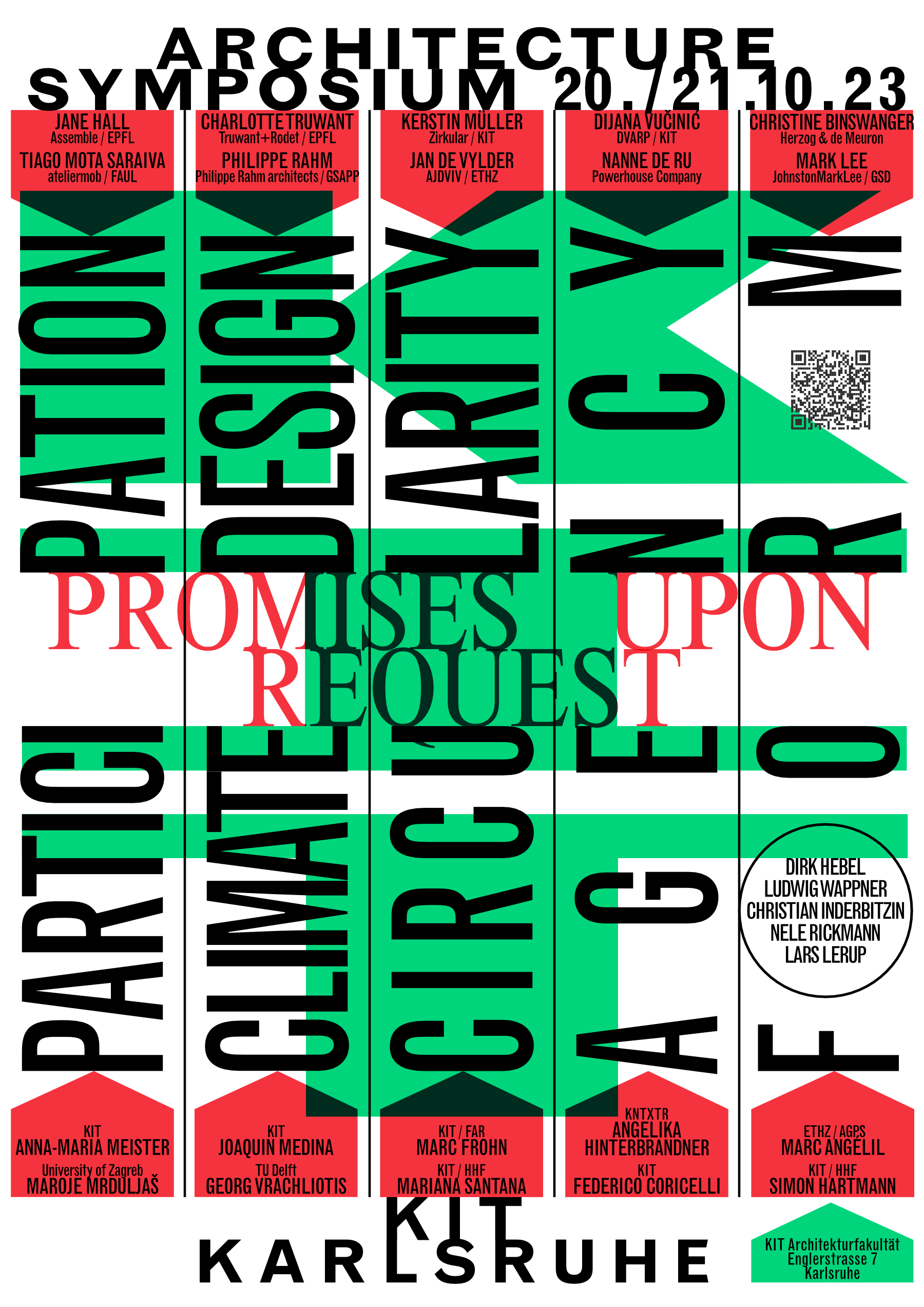↵PROMISES UPON REQUEST
KIT – Karlsruhe Architecture Symposium – October 20-21, 2023
Growing climate awareness puts architects in a position to comply with more and more specific demands from society, targeting the core of the profession from the outside. In response to these demands, positions emerged within the discipline, promising sustainable approaches to ecological resilience, social inclusion, and economic responsibility:
The Promise of Participation
Participation challenges the idea of the architect as sole author. Built upon the idea of "Nothing about us without us," architects no longer serve as the principal decision-makers; instead, they act as mediators of the interests negotiated by others. To what extent can this shifted role still produce what was formerly known as architecture? Does the promise of participation lead to “Architecture without Architects”, or rather to “Architects without Architecture”?
Participation challenges the idea of the architect as sole author. Built upon the idea of "Nothing about us without us," architects no longer serve as the principal decision-makers; instead, they act as mediators of the interests negotiated by others. To what extent can this shifted role still produce what was formerly known as architecture? Does the promise of participation lead to “Architecture without Architects”, or rather to “Architects without Architecture”?
The Promise of Climate Design
Advancements in scientific research have opened up new avenues for designing and controlling climates. Data production and collection become key to evaluating architectural projects. The emergence of new models questions the adaptation and updating of past architectural constructions. Does the promise of climate design narrow the discipline to aspects that can be simulated, measured and controlled?
Advancements in scientific research have opened up new avenues for designing and controlling climates. Data production and collection become key to evaluating architectural projects. The emergence of new models questions the adaptation and updating of past architectural constructions. Does the promise of climate design narrow the discipline to aspects that can be simulated, measured and controlled?
The Promise of Circularity
If we consider buildings as temporary configurations of components to be reused or designed for future disassembly, we risk reducing buildings to nothing but the sum of their parts.
If we consider buildings as temporary configurations of components to be reused or designed for future disassembly, we risk reducing buildings to nothing but the sum of their parts.
Does the promise of circulation and a known afterlife for all components of a building fall in the same trap as previous attempts to control the future of a man-made system? Do we really want to extinguish decay and prevent the ruin?
The Promise of Agency
Professionalized developers drain a substantial amount of money from construction and project development, enticing architects to promote self-initiated projects and identify alternative funding strategies. To shift agency to those outside of the conventional power structures that shape the built environment promises political and social relevance for architecture.
Professionalized developers drain a substantial amount of money from construction and project development, enticing architects to promote self-initiated projects and identify alternative funding strategies. To shift agency to those outside of the conventional power structures that shape the built environment promises political and social relevance for architecture.
Does this promise of agency really change how architectures are produced, or does it produce a tokenized new value to overcome the traditional competitive structure?
The Promise of Form
The current change of shared values comes with a catalog of objective forms deduced from best practices directly impacting architectural expression. Is this how we want architecture to look? How can architectural form free itself from this new functionalism without denying the changed conditions? What about form can be discussed without slipping back (or forward) into meaningless formalist clichés?
The current change of shared values comes with a catalog of objective forms deduced from best practices directly impacting architectural expression. Is this how we want architecture to look? How can architectural form free itself from this new functionalism without denying the changed conditions? What about form can be discussed without slipping back (or forward) into meaningless formalist clichés?
Guests
Marc Angelil
Georg Vrachliotis
Maroje Mrdjulas
Dijana Vučinić
Marc Angelil
Georg Vrachliotis
Maroje Mrdjulas
Dijana Vučinić
Angelika Hinterbrandner
Philippe Rahm
Jan de Vylder
Kerstin Müller
Jane Hall
Mark Lee
Christine Binswanger
Tiago Mota Saraiva
Lars Lerup
Charlotte Truwant
Nanne de Ru
Philippe Rahm
Jan de Vylder
Kerstin Müller
Jane Hall
Mark Lee
Christine Binswanger
Tiago Mota Saraiva
Lars Lerup
Charlotte Truwant
Nanne de Ru
KIT Respondants
Simon Hartmann
Anna-Maria Meister
Joaquin Medina
Federico Coricelli
Mariana Santana
Marc Frohn
Christian Inderbitzin
Dirk Hebel
Judith Reeh
Ludwig Wappner
Simon Hartmann
Anna-Maria Meister
Joaquin Medina
Federico Coricelli
Mariana Santana
Marc Frohn
Christian Inderbitzin
Dirk Hebel
Judith Reeh
Ludwig Wappner
Critics And Media
Nele Rickmann
Moana Ühlein
Nele Rickmann
Moana Ühlein

